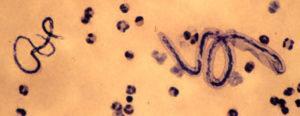Helminth infections are worm parasites that are often situate themselves in the intestines or blood vessels and are extremely prevalent globally. Nearly a quarter of the world’s population is currently infected with helminth parasites. Helminths disturb nutrient absorption and impair the nutritional status of those infected. Consequently, infected individuals are often found to be weak or coinfected with one or more other diseases. Moreover, helminth infections are disproportionately found in poorer, underserved populations, where communities are also burdened with malnutrition or HIV. In these cases, it is often difficult to determine whether poor nutrition or infection occurred first. The potential ‘triple burden’ makes it challenging to recover.
HIV-helminth coinfections are associated with lower biochemical micronutrients and protein and carbohydrate levels. Additionally, several nutrient deficiencies have been found to increase the probability of HIV-helminth coinfection. It is believed that various nutrient deficiencies cause impaired immunity.
In the South African province KwaZulu-Natal, improper sanitation and lack of access to safe water is common and helminth prevalence can reach up to 30% regionally. Furthermore, KwaZulu-Natal has the highest provincial HIV prevalence in South Africa at 37%. South African researchers assessed the nutritional status of HIV-helminth coinfected Durbanite adults using body mass index (BMI), immediate food recall, and biochemical markers of micro- and macronutrients. Participants were tested for HIV, as well as parasite eggs or ova for helminth infection. Through demographic analysis, it was revealed that the majority of participants were female, unemployed, and of a low socioeconomic status. More than 60% of participants did not have access to flush toilets and nearly half of participants did not have a source of tap water within their home.
When assessing anthropometry, there were no significant differences of standard BMI intervals between groups. Across all groups, including the control, multiple micronutrient intake levels were lower than the required daily intake. Notable micronutrients included calcium, magnesium, folate, and vitamins A, C, D, E, and K. At the macronutrient level, there were no significant differences between groups and their intakes. Notably, all groups indicated excess carbohydrate intake, despite low general energy intake. However, measured biomarkers yielded significant differences. The coinfected cohort had lower transferrin and ferritin levels, through percentage of transferritin saturation were higher in those infected with HIV. Total protein was higher and haemoglobin was lower in the coinfected and HIV-infected groups. It is hypothesized that protein levels synthesized by the liver are affected by both nutritional status, and infection and inflammation. Furthermore, HIV infection increases globulin from B cell stimulation. This may explain the increased protein levels of HIV-infected groups.
Mkhize et al. demonstrated that though nutritional intake may not be associated with patients, it does have substantial impact on their nutritional status. Furthermore, nutritional intake and reporting is highly variable between participants and can be heavily influenced by demographic factors. Though hypotheses were made in association with HIV, this study concludes that both HIV and helminth infection are pertinent. Helminth infections are often neglected, but must be considered particularly in high-risk areas, as well as in HIV endemic regions. Studying HIV-helminth coinfections further uncovers the issue as a global health burden, where patients are often plagued by multiple illnesses and their consequences.
Article by Rebecca Ng












